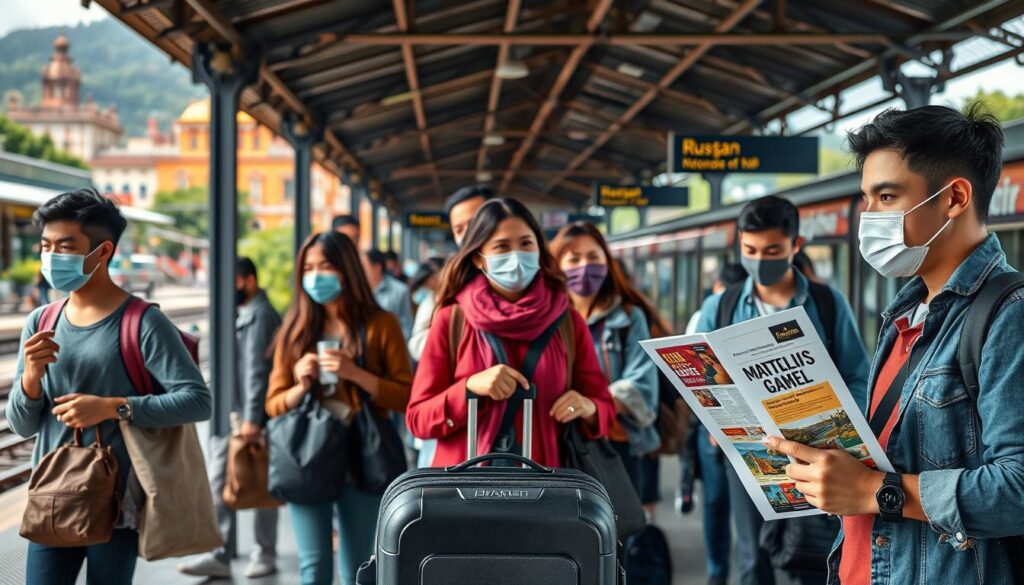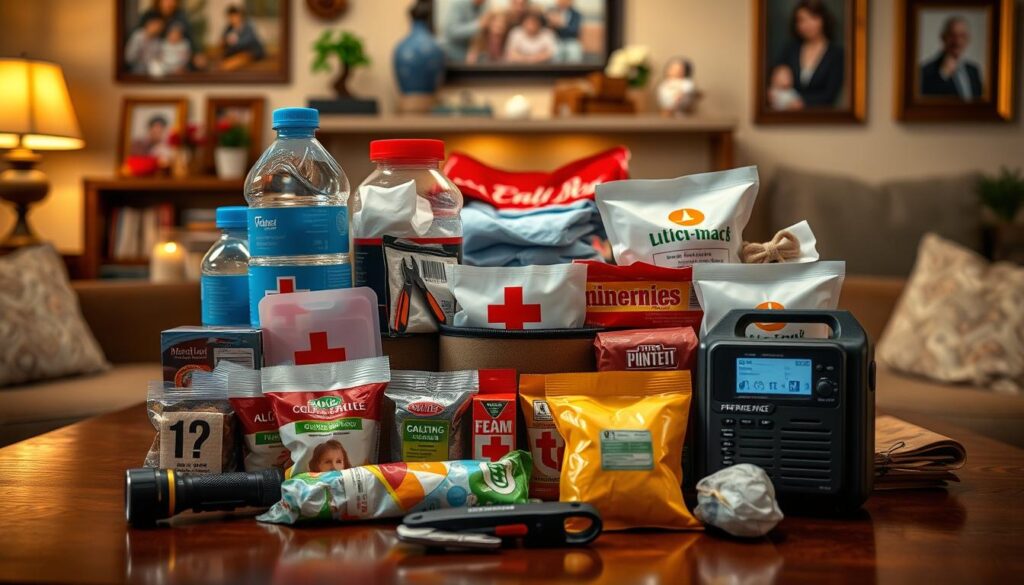In today’s fast world, keeping safe can be easy to forget. Yet, it’s key to stay safe every day to protect yourself and your family. This guide will show you how to stay safe in many areas of life. You’ll learn about home security, online safety, and how to stay safe when you travel.
Key Takeaways
- Develop a safety-first mindset to prioritize personal safety in everyday life
- Establish daily safety habits to create a safer environment at home, work, and during travel
- Understand common safety risks and take proactive measures to mitigate them
- Implement essential home security measures to protect your family
- Secure your digital life by practicing robust cybersecurity practices
Understanding the Foundations of Personal Safety
Personal safety is key to a secure and happy life. By focusing on safety first, we can lower risks and feel more confident every day. It’s important to build good safety habits to spot and solve common dangers early.
Developing a Safety-First Mindset
A safety-first mindset is the base of personal security. It means always being aware of your surroundings and trusting your gut. It also means putting safety first in everything you do. This way, you make choices that keep you safe and improve your life.
Creating Daily Safety Habits
- Make a routine to check your home’s security, like locking doors and windows.
- Learn the safest ways to get to work or school.
- Always use strong passwords and be careful online to protect yourself from cyber threats.
Identifying Common Safety Risks
Knowing the common dangers is crucial for safety. This knowledge helps you take steps to avoid them. Some common risks include:
- Home Invasions
- Carjackings
- Cybercrime and Identity Theft
- Workplace Violence
- Natural Disasters and Emergencies
By focusing on safety, building good habits, and knowing the risks, you can stay safe and feel more confident. This approach helps you face the world with strength and resilience.
“The first step to personal safety is recognizing that you have the power to protect yourself.”
Essential Home Safety Measures to Protect Your Family
Keeping your home safe is a top priority for any family. By taking key safety steps, you can protect your loved ones from harm. Let’s look at how to make your home safer and give your family peace of mind.
Installing Security Systems and Cameras
Getting a home security system is a smart move. These systems have motion sensors, cameras, and smart home features. They help keep burglars away and alert you quickly if there’s a problem. They also let you check on your home from your phone or tablet.
Securing Doors and Windows
Keeping your doors and windows safe is crucial. Using strong locks can help stop unwanted visitors. You can also add extra security with reinforced frames, deadbolts, and tamper-proof locks.
Creating Emergency Exit Plans
Being ready for emergencies is key to keeping your family safe. Make a detailed exit plan with several ways out, meeting spots, and emergency supplies. Practice fire drills and talk about emergency plans to help your family act fast in an emergency.
By following these safety steps, you can make your home a safe place for your family. Being proactive about home security is the best way to protect your loved ones and your home.
| Home Safety Measure | Description |
|---|---|
| Security Systems and Cameras | Advanced home security systems with motion sensors, surveillance cameras, and smart home integration to deter burglars and provide real-time alerts. |
| Securing Doors and Windows | High-quality locks, reinforced door frames, sturdy deadbolts, and tamper-resistant window locks to create an additional layer of protection against intruders. |
| Emergency Exit Plans | Develop clear and well-rehearsed emergency exit plans with multiple escape routes, designated meeting points, and easy access to emergency supplies. |
Cybersecurity: Protecting Your Digital Life
In today’s world, cybersecurity is a big deal for everyone. We use technology a lot, so keeping our info safe is key. This includes using strong passwords and safe browsing.
Cyber threats are many, like phishing and malware. Hackers want to get into our digital lives. Knowing about these threats helps us stay safe.
Good cybersecurity starts with strong passwords. Don’t use easy ones. Use a password manager for complex, unique passwords. Two-factor authentication adds extra security, making sure only you can get in.
| Type of Cyber Threat | Description | Potential Impact |
|---|---|---|
| Phishing | Fraudulent emails or messages designed to trick users into revealing sensitive information or installing malware | Identity theft, financial loss, data breaches |
| Malware | Malicious software that can infect devices, steal data, or disrupt systems | Data loss, system disruption, financial damage |
| Social Engineering | Manipulative tactics used to exploit human behavior and gain unauthorized access | Compromise of sensitive information, unauthorized access to systems |
By being careful and using the right tools, we can keep our digital lives safe. This protects us and our loved ones from online dangers.
“Cybersecurity is not just an IT issue, it’s a business issue. The security of our digital lives is essential for our personal and professional well-being.” – Cybersecurity Expert
Safe Travel Practices for Daily Commute and Vacations
Traveling safely is a big deal, whether it’s for work or fun trips. By following key travel safety tips, you can have a safe and fun trip. This is true whether you drive, use public transport, or visit new places.
Vehicle Safety Essentials
Keeping your car in good shape is key for travel safety. Regular checks, tire checks, and fixing any car problems can stop breakdowns and accidents. Always wear your seatbelt, follow traffic rules, and don’t get distracted while driving.
Public Transportation Safety Tips
- Plan your route and know the public transportation schedules and routes.
- Stay away from lonely spots and travel when it’s busier.
- Keep your things close and watch your surroundings.
- Listen to your gut and stay away from places that feel off.
Travel Security Guidelines
When you’re on a vacation or checking out a new city, safety is crucial. Learn about your destination, know the local laws and customs, and have copies of important papers. Think about getting a portable safe or using hotel safes for your valuables.

“Preparation is the key to a safe and enjoyable journey. By taking proactive steps, you can focus on creating lasting memories without compromising your well-being.”
By adding these travel safety tips to your daily life and vacation plans, you can travel with confidence and peace of mind.
Workplace Safety Protocols and Best Practices
Keeping the workplace safe is a big job for everyone. Employers and employees must follow safety protocols and best practices. This helps make a safe and productive place to work. It’s all about keeping everyone healthy and safe.
Ergonomics and Workstation Design
Good ergonomics can prevent many injuries. Make sure workstations, chairs, and computers are set up right. This helps avoid back and neck pain.
It’s also good to take breaks and do some stretching. This helps fight the effects of sitting too much.
Emergency Preparedness and Response
- Make sure you have clear safety protocols for emergencies like fires or natural disasters.
- Do drills and training to teach everyone how to get out safely and find first aid.
- Make sure there are easy ways to get out, fire extinguishers, and first aid kits everywhere.
Hazard Identification and Risk Mitigation
Encourage everyone to watch out for dangers like slippery floors or broken equipment. Have a plan to quickly fix these problems. This keeps the workplace safe.
“Investing in workplace safety not only protects your employees, but also enhances productivity, reduces costly accidents, and demonstrates your commitment to corporate social responsibility.”
Creating a safe work culture is key. It makes everyone feel valued and safe. This is the best way to take care of your most important asset – your people.
Self-Defense Techniques and Awareness Training
In today’s world, knowing how to defend yourself is key. This includes learning self-defense moves and staying alert. We’ll cover the basics of self-defense and how to stay safe in different situations.
Basic Self-Defense Moves
Learning a few simple self-defense moves can be very helpful. Here are some basic techniques everyone should know:
- The palm strike: A quick, strong hit to the attacker’s face or weak spots can help you get away.
- The knee strike: A fast knee hit to the attacker’s groin or belly can cause pain and confusion.
- The elbow strike: A sharp elbow hit to the attacker’s ribs, face, or neck can help you gain control.
Situational Awareness Tips
Knowing what’s around you is crucial for staying safe. Being aware of your surroundings helps you react to dangers. Here are some tips:
- Always look around, noticing where you can go, where to hide, and any odd behavior.
- Listen to your gut: If something feels off, it probably is. Get out of there if you can.
- Stay alert, not distracted. Avoid using headphones or phones too much, as they can make you an easy target.
Emergency Response Strategies
Having a plan for emergencies is vital. Here are some strategies to keep you safe:
| Strategy | Description |
|---|---|
| Escape and Evade | Get to a safe place fast, trying not to face the attacker directly. |
| Verbal De-escalation | Speak calmly but firmly to try and calm the situation down. |
| Call for Help | Call emergency services or tell others nearby to help. |
Learning these self-defense moves, staying alert, and having a plan for emergencies can make you safer. You’ll feel more confident in facing dangerous situations.
Child Safety Guidelines for Parents and Guardians
Ensuring our children’s safety is our top priority. We will cover essential guidelines to protect them in different areas of their lives.
Childproofing Your Home
Creating a safe home environment is key. This means installing safety gates and covering sharp edges. Also, secure cabinets with childproof locks and keep dangerous materials out of reach. Regularly check and update your home’s safety features as your child grows.
Educating Children About Stranger Danger
Teaching kids about stranger dangers is vital. Talk openly, role-play, and stress the no-gifts-or-rides rule from unknown people.
Monitoring Online Activities
In today’s digital world, watching your child’s online activities is crucial. Check their content, set limits, and talk about online dangers. Encourage them to use the internet responsibly.
Ensuring School Safety
Work with your child’s school to know their safety plans and emergency steps. Stay updated on their safety measures, like visitor checks and drills. This helps in keeping your child safe.
“The greatest gift we can give our children is the confidence to keep themselves safe.”
By following these guidelines, parents can help their children stay safe. This empowers them to be aware and confident in the world.
| Safety Aspect | Key Guidelines |
|---|---|
| Home Safety |
|
| Stranger Danger |
|
| Online Safety |
|
| School Safety |
|
Emergency Preparedness and First Aid Basics
Unexpected emergencies and natural disasters can happen anytime. Knowing first aid can save lives. We’ll cover the basics of emergency preparedness and first aid to help you handle crises.
Essential First Aid Skills
First aid is key to being ready for emergencies. Learn the basics, like:
- Performing CPR and rescue breathing
- Treating cuts, burns, and minor injuries
- Spotting and handling shock, allergic reactions, and other emergencies
- Safe transport of injured people
Creating Emergency Kits
A good survival kit is essential for any emergency plan. Make a kit with important items, such as:
- First aid supplies (bandages, antiseptic, pain relievers)
- Non-perishable food and water
- Flashlights, batteries, and a radio
- Warm clothes, blankets, and hygiene items
- Important documents and emergency contact info
Natural Disaster Preparation
Know the disasters that could hit your area. Learn how to protect your family. This includes:
- Finding safe evacuation routes and shelters
- Securing your home
- Stocking up on supplies for disaster readiness
- Practicing emergency drills and communication plans
Learning first aid basics and being prepared can save lives. Stay ready and informed to face emergencies with confidence.

Mental Health Safety and Stress Management
In today’s fast world, taking care of our mental health is key. It’s vital to keep our emotional and psychological well-being in check. This helps us deal with life’s daily challenges.
Stress can harm our health, causing anxiety, depression, and burnout. To fight this, we need healthy ways to cope. Mindfulness, exercise, and talking to friends or professionals can help. Having a strong support system and taking care of ourselves is crucial.
Knowing where to find mental health help is also important. Online platforms, support groups, and counseling can offer the support we need. Taking a holistic approach to safety, including both physical and mental health, improves our life quality.
FAQ
What are some essential home safety measures to protect my family?
To keep your family safe at home, think about getting security systems and cameras. Also, make sure doors and windows are locked. Having a plan for emergencies is key to safety.
How can I stay safe when traveling or commuting?
When you travel, focus on keeping your vehicle safe. Be careful when using public transport and follow travel safety tips. Being alert and ready can make your trips safer.
What are some basic self-defense techniques I should know?
Learning simple self-defense moves is important. Also, stay aware of your surroundings and know how to respond in emergencies. Taking self-defense classes can be very helpful.
How can I keep my children safe at home and in the community?
Make your home safe for kids by childproofing it. Teach them about stranger danger and watch their online activities. Helping kids learn about safety can keep them safe.
What are some essential first aid skills and emergency preparedness steps I should take?
Knowing basic first aid is crucial. Also, have a good emergency kit ready. Being ready for disasters can save lives.
How can I prioritize my mental health and manage stress for improved personal safety?
Taking care of your mental health is important for safety. Managing stress helps keep you safe. If you need help, don’t hesitate to seek it.
What are the best practices for maintaining cybersecurity and protecting my digital life?
Use strong passwords and be careful online. Protecting your personal info is key to avoiding cyber threats. Keeping your digital life safe is essential today.
How can I create a safety-first mindset and develop daily safety habits?
Being safety-conscious is important. Add safety habits to your daily routine. Knowing risks and acting on them can make you safer every day.
